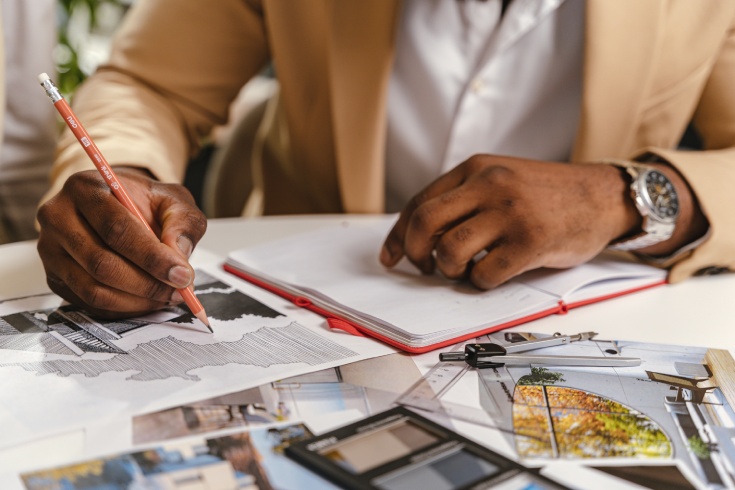Architect Advice on Optimizing Compact Urban Spaces
Architect Advice on Optimizing Compact Urban Spaces
Blog Article
The Duty of Sustainability and Technology in Modern Architect Practices
Sustainability and modern technology are improving modern-day style in methods you may not expect. By welcoming wise developments and eco-friendly products, designers are not just creating structures; they're crafting atmospheres that enhance our lifestyle. This shift isn't simply concerning aesthetics or capability; it has to do with creating an accountable approach to our planet's future. What's driving this makeover, and exactly how can these changes influence your community?
The Value of Sustainable Design
Lasting architecture is necessary not just for the atmosphere yet also for improving our top quality of life. You're not just lowering your carbon impact; you're creating spaces that promote wellness and health when you embrace sustainable style. Visualize living in a home that utilizes natural light, boosts air top quality, and reduces energy costs. You'll feel much more connected and comfortable to nature.
Additionally, sustainable design commonly brings about more powerful neighborhoods. When buildings are developed with green techniques, they can motivate others to adhere to match, promoting a culture of sustainability. You'll observe increased home values and a higher feeling of pride in your surroundings.
Last but not least, by prioritizing sustainability, you're purchasing the future. You're ensuring that future generations delight in a healthier planet and dynamic communities. When you consider your following task, think about exactly how lasting architecture can boost your life and those around you.
Innovative Materials Changing Building Practices
As you explore cutting-edge materials in architecture, you'll discover that naturally degradable building materials are reshaping how we think of sustainability. Recycled content innovations are offering new life to waste, while wise product innovations boost developing efficiency. These advancements not only promote eco-friendliness however additionally push the borders of style.
Biodegradable Building Materials
While standard building and construction products usually add to ecological destruction, eco-friendly building materials are emerging as a viable choice that changes building practices. By incorporating biodegradable alternatives right into your styles, you're not just enhancing aesthetic appeal; you're also making a positive effect on the planet. As you adjust to these cutting-edge materials, you'll find that they offer durability and convenience, enabling you to create structures that line up with contemporary values of sustainability and obligation.
Recycled Content Developments
In the last few years, innovative products with high recycled material have transformed building methods, providing architects interesting new options - Architect. You can currently integrate materials like recycled steel, which not just decreases waste yet likewise flaunts outstanding toughness. Recycled glass is one more wonderful choice, giving aesthetic allure while minimizing ecological impact

Smart Material Technologies
Smart product modern technologies are reshaping the method you assume about developing practices, using vibrant solutions that adapt to altering problems. These innovative materials, such as self-healing concrete and thermochromic glass, improve structure performance and sustainability. Think of frameworks that can readjust to temperature changes or repair themselves when harmed-- these innovations are no longer simply principles. By incorporating clever products, you can produce energy-efficient layouts that react to their environment, lowering total power consumption. The capacity to adapt and keep track of in real-time streamlines maintenance and extends the life expectancy of buildings. As you embrace these innovations, you're not simply innovating; you're adding to an extra sustainable future in architecture, merging functionality with ecological duty.
The Combination of Smart Technologies in Design
As innovation progresses, integrating clever remedies right into building style comes to be crucial for developing sustainable and efficient areas. You can integrate wise innovations like developing monitoring systems, which optimize power use and enhance owner convenience. Sensing units can check ecological conditions, changing illumination and temperature level automatically based on real-time information. This versatility not just enhances customer experience however additionally lowers energy consumption.
Incorporating Web of Things (IoT) tools permits for seamless communication amongst numerous building systems, enabling you to make data-driven choices that boost capability. Smart products that reply to environmental adjustments can additionally enhance your design, supplying dynamic options to ever-changing conditions.
Energy Effectiveness and Renewable Power Solutions
While lots of architects concentrate on aesthetic appeals, prioritizing power performance and eco-friendly energy solutions is crucial for lasting design. You can start by integrating passive solar style, which maximizes all-natural light and heat, decreasing reliance on man-made illumination and furnace. Utilize high-performance insulation and energy-efficient home windows to decrease power loss.
Don't ignore renewable resource systems-- install photovoltaic panels or wind turbines to produce clean power on-site. You can likewise consider integrating geothermal heating and cooling down systems for a more lasting temperature level guideline.
By picking energy-efficient appliances and lights, you'll not just decrease power consumption yet likewise reduced operational prices for building owners.
Incorporating these principles right into your layouts not just profits the setting yet additionally improves the building's charm and value. Eventually, your dedication to power performance and renewable energy will certainly set your projects apart in an open market.
Water Conservation Approaches in Modern Style
Including water conservation approaches into modern architecture is essential for creating lasting buildings that decrease environmental impact. You can achieve this by incorporating rainwater harvesting systems, which keep his comment is here and collect rain for watering and non-potable uses. Implementing low-flow components and wise watering systems additionally minimizes water intake, guaranteeing effective use throughout the building.
Take into consideration utilizing drought-resistant landscape design, which calls for much less water and advertises biodiversity. Including absorptive paving products enables rainwater to penetrate the ground, reducing runoff and recharging groundwater materials.
Furthermore, mounting greywater recycling systems can repurpose water from sinks and showers for bathroom flushing or irrigation, additional preserving resources.
The Effect of Biophilic Style on Health
Biophilic style brings nature indoors, and you'll notice its favorable effects on your health and wellness and happiness. By boosting interior air quality and connecting you with natural aspects, these spaces can change your day-to-day experience. Let's explore how incorporating these features can improve your general wellness.
Nature's Influence on Health and wellness
When you integrate components of nature into your environments, it can substantially boost your mental and physical health. Biophilic design, which stresses natural light, plants, and organic products, cultivates a feeling of connection to the outdoors. Embracing biophilic layout is an action toward a much healthier lifestyle.
Enhancing Indoor Air Quality
While numerous individuals concentrate on looks and performance in style, enhancing indoor air top quality plays a necessary role in your general wellness. Poor air top quality can result in health and wellness concerns like migraines, exhaustion, and respiratory system problems. By integrating biophilic design elements, you can improve air quality naturally. Plants, as an example, not just improve your area but additionally filter toxic substances and boost oxygen degrees. Utilizing materials with reduced unpredictable natural substances (VOCs) further adds to a healthier interior setting. Additionally, making best use of natural air flow assists decrease interior contaminants. Focusing on these elements in your design will certainly not only raise your space however additionally promote a feeling of calmness and health. Inevitably, a concentrate on air high quality is important for a sustainable and healthy living atmosphere.
Connection With All-natural Aspects
When you get in touch with natural aspects in your room, you not only boost its visual charm however additionally significantly boost your wellness. Biophilic design urges you to integrate functions like plants, natural light, and natural materials. These aspects create a soothing ambience, minimizing stress and anxiousness. Study reveals that being around nature can improve your mood and cognitive feature, aiding you feel more concentrated and productive. When you invite the outdoors inside, you may observe better air high quality and raised comfort. Easy modifications, like adding a living wall or huge windows, can exceptionally impact your experience (Architect). Ultimately, incorporating nature right into your atmosphere leads you to a healthier, better way of life, promoting a much deeper link to the globe around you.
Future Trends in Lasting Building Practices
As the world encounters pushing environmental difficulties, architects are significantly welcoming cutting-edge strategies to sustainability that redefine how we style and develop. You'll see a surge in biophilic design, incorporating nature click for info right into urban spaces to improve well-being and lower energy intake. Smart modern technologies, like AI and IoT, are improving energy monitoring in buildings, maximizing source use, and minimizing waste.
Furthermore, modular building and construction is acquiring grip, permitting faster, more efficient building processes while minimizing ecological effect. Using lasting products, such as reclaimed wood and recycled steels, is coming to be common technique. As you discover these patterns, expect a shift toward round layout, stressing the lifecycle of materials and promoting reuse and recycling.
These forward-thinking strategies not just address ecological concerns but also create healthier, more resistant communities. By remaining informed about these trends, you can help form a sustainable future in architecture.
Often Asked Questions
Exactly How Can Sustainability Affect Project Prices and Spending Plans?
Sustainability can substantially affect task prices and budgets. You might locate that preliminary financial investments in green materials or innovations bring about lasting savings with energy efficiency, decreased waste, and potential government rewards, ultimately balancing the general expenses.
What Accreditations Exist for Lasting Style?
You'll find numerous certifications for sustainable design, consisting of LEED, BREEAM, and the Living Structure Obstacle. These certifications assist you demonstrate your commitment to sustainability and can enhance your job's trustworthiness and interest customers.
Just How Does Neighborhood Society Impact Lasting Style?
Local society shapes lasting design by reflecting community materials, traditions, and values. You'll discover that integrating local looks and techniques not just values heritage however additionally boosts the functionality and approval of your architectural jobs.
What Role Does Client Education Play in Sustainable Practices?
Customer education's essential for promoting lasting techniques. read this When you educate clients regarding benefits, prices, and environmental influences, you encourage them to make educated choices, cultivating a collaborative strategy that improves the project's total sustainability.

Exactly How Can Architects Determine the Success of Sustainability Initiatives?
You can gauge the success of sustainability campaigns by tracking energy usage, evaluating product effectiveness, and event comments from customers. Normal audits and comparisons against benchmarks will certainly aid you fine-tune your methods and display enhancements properly.
By integrating smart materials, you can develop energy-efficient styles that respond to their atmosphere, minimizing overall power usage.While numerous designers concentrate on aesthetics, prioritizing energy performance and eco-friendly power services is essential for lasting style. Biophilic design, which highlights all-natural light, plants, and organic products, cultivates a sense of link to the outdoors. Biophilic design urges you to incorporate functions like plants, all-natural light, and natural products. As you explore these patterns, anticipate a shift toward round design, emphasizing the lifecycle of products and promoting reuse and recycling.
Report this page